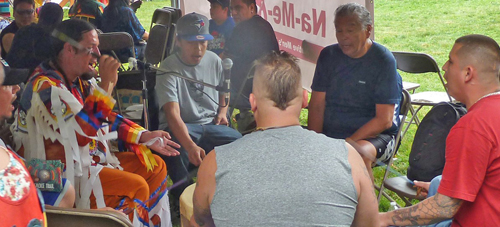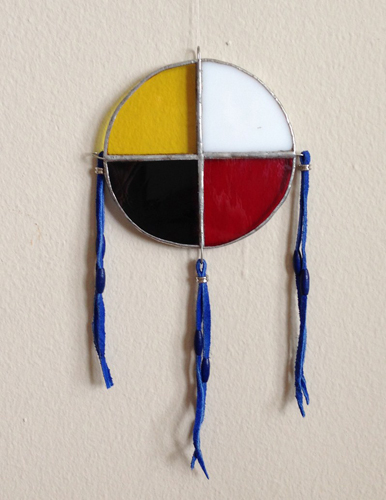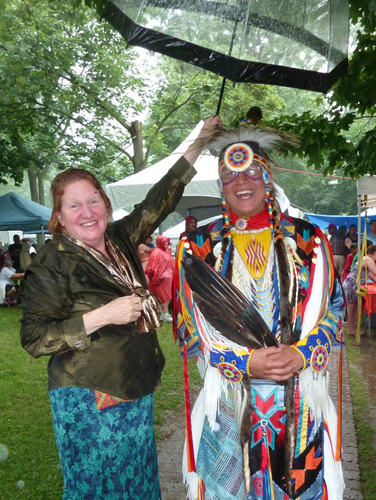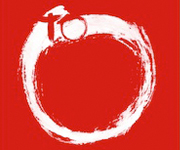2 Jul
Have you ever attended a real Pow Wow gathering with different First Nations? What does it look like? What do these people feel inside when dancing in a circle to the beat of drums? How do they experience it? 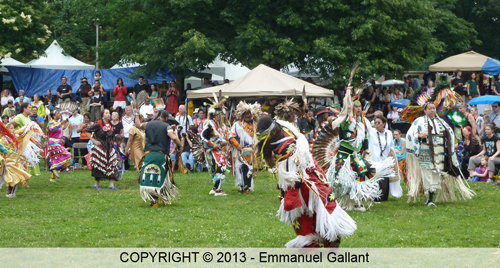
Recently, I got the answers to most of my questions. (See also video URL below.)
As a recently-landed Toronto immigrant, I love to immerse myself in most of the cultures of the city. I try to “catch the core” of each of them especially that of the very first inhabitants of Canada. Emmanuel Gallant.
It is raining heavily when I arrive at the intersection of St. Clair and Bathurst at 12:25pm. As I don’t know exactly where Wells Hill Park is located, I simply let the sound of drums guide my way. In the middle of the park, twenty Natives are dancing, one behind the other, forming a large circle. All are dressed in their typical colorful ceremonial regalia. They are moving to the beat of the drums, played by fifteen of their brothers, who are in three little groups. They are under the main shelter, singing as one voice. Everyone else is standing although there are numerous chairs.
- Native Drummers. Copyright ©2013 Emmanuel Gallant
I manage to get a good view and take my camera out. Instantly, one of the First Nations people comes to me and says: “No pictures are allowed for the three first dances!” A bit surprised, I put the camera back in my bag. This is obviously the sacred part of the ritual. Never mind, I will wait a little bit and observe carefully what’s happening.
I had already attended an aboriginal dance a few weeks before at the Carassauga festival but never a Pow Wow where most of the spectators and dancers are Native. In the middle of the large circle stand four flags: USA, Canadian, and Mohawk which has a native male head on a yellow sun, all on a red background. There is also the flag of the Six Nations which is purple and white.
Then everyone listens as an elder reads a text in his own language. This is followed fortunately by an English translation. He shortens the prayer to make time for the dance. Perfect.
Then the master of ceremonies invites all US or Canadian military veterans to join the Pow Wow for the “ogichida” dance. (I checked the spelling once back home. It means “dance of veterans” in the Ojibwe language). A few others join the men for this five-minute segment. I recognize the young girl who was performing at Carassauga, dressed in her green, yellow and red regalia. I like the way she dances, her feet moving a lot as her arms wave in different directions. She obviously completely lives the music. 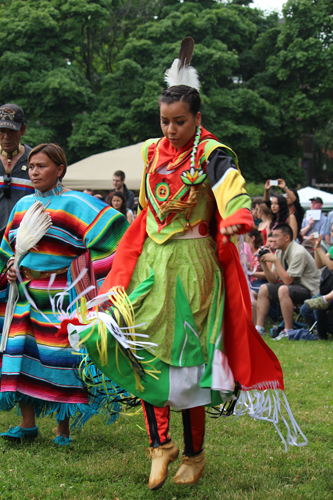
- Copyright ©2013 Ruth Lor Malloy
As it starts to pour, I rush under the trees, where the booths are, and take a look at the traditional aboriginal articles for sale. The moment is perfect for a little chat with one of the sellers, a woman called Cory:
“Hello, do you understand what they were saying previously?”
“No this is not my language. I come from another tribe, Cree, from Alberta.”
“When did you arrive here?”
“Oh, long time ago. I now have my own business here, with my husband. We do art work. We have a stained glass company. But this is not all. Part of our activity consists in teaching young people to carry on the trade, how to make footwear, how to dance.”
“Do you teach only First Nations people?”
“Not only First Nations. We teach all those who desire to learn.”
“Can you tell me more about the items you sell?”
“This is a dream catcher. It is usually used for young children who are having bad dreams. The dreams go right into the net and gets stuck inside” (She shows me with her hand).
“And this one?”
“Those are Medicine Wheels (also called ‘sacred hoops’). As you can see, a Medicine Wheel is a round stained wheel divided in four parts, with four different colours: white, black, yellow, red. Each of them represent a cardinal point: north, south, east, west. They also symbolize the different seasons and the colours of humans: Caucasians, Africans, Asians and Natives. It is a very meaningful item.”
Seduced, I buy a nice $20 Medicine Wheel before getting back to the Pow Wow. It has temporarily stopped raining.
Finally, the crowd is allowed to take pictures of the next events. Natives of all ages start dancing “the travel dance” in the same way, progressing in a clockwise circle. What surprises me the most is that there are apparently no real rules to the dance. Everyone moves in his own way, while respecting the pace. This changes a bit my original picture of totally synchronized First Nations dances. Some of the dancers progress quite slowly, putting their arms on their hips. Others agitate their arms and pad the grass much more than the others.
The “travel dance” ends up being more of a rain dance. It starts pouring again. But the dancers do not seem to mind and keep dancing. I think it is a great example of their connection with nature.
When the dance finishes, I go to one of the dancers to learn more about this “spirit”. Michael answers my questions with a large smile.
“Michael, what is your origin?“
“Actually I come from the “Blood Tribe” reserve. It is located in Alberta. I have been living in Toronto for three years now to study at the Indigenous theatre.“
“What does Indian traditional dance represent to you?“
“It is a source of healing. There is a very strong spirit of communion between Indians. To give you an example, I have my own family but also my Pow Wow family. Inside the Pow Wow family, we visit and help each other a lot. Nevertheless, strong links don’t mean that there is no competition. Sometimes, we also have Pow Wow competitions, with judges voting for the best performance.“
“How do you feel about non-indigenous joining you and dancing?“
“I feel fine with this idea. Actually our dance has a lot to do with teaching. We tell a story and teach people while dancing. It is a celebration of life, of healing. Together, we celebrate the creation, the connection of the earth to the sky, represented by the sound of drums. Each dance has its own story and everybody has his own style.“ (As he speaks, he mimics the energy going through him)
“What is your style? “
“Mine is a grass dance, called ‘blade of grass’. This is basically a dance that thanks the earth for helping us find the land for our camp. Therefore, when I dance, I imitate the chicken, which is a symbol of the earth and I pad down the grass a lot, without breaking the blades. To me, a Pow Wow really is a grounding that builds confidence and brings a lot of fun.“
As he goes back to the “dance floor”, I decide to head back home, partially soaked, totally happy about what I learned today.
Emmanuel’s video:
http://www.youtube.com/watch?v=8HGt5j0wt8w&feature=youtu.be
Note: Please also share your multicultural adventures with us at ruthlormalloy@gmail.com .

